Experiments
King Gustav III’s Coffee Experiment
According to what may be legend, King Gustav III of Sweden conducted that country's first clinical trial during the second half of the 18th century. He wanted to determine whether drinking coffee was bad for one's health. He firmly believed it was. The story is told on the website of Sweden's Uppsala University Library: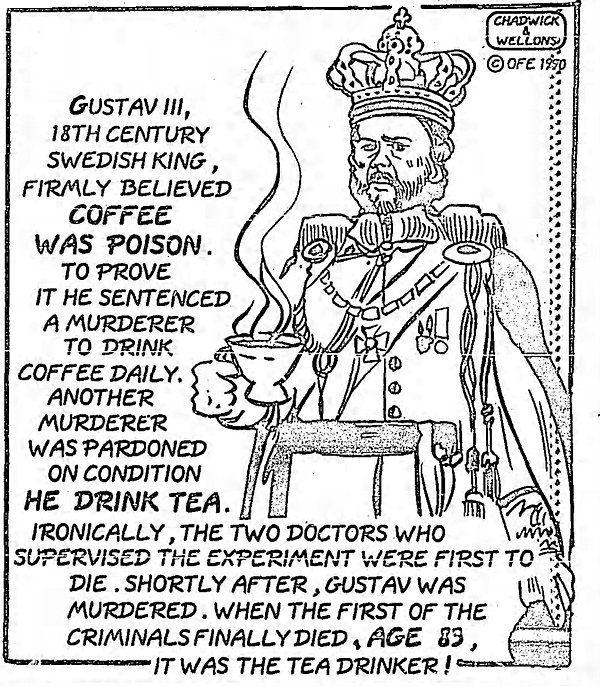
Barstow Desert Dispatch - Jan 7, 1991
Wikipedia notes that the authenticity of the coffee experiment story has been questioned. Though it doesn't say why.
As far as I can tell, the earliest English-language reference to the story appeared in a 1937 issue of The Science News-Letter. This account was then widely reprinted in newspapers (see below).
The Science News-Letter attributed the information to the Swedish-born botanist Bror Eric Dahlgren, who was a curator at the Field Museum in Chicago. Dahlgren did author a 1938 pamphlet about the history of coffee, which you can read online at the Biodiversity Heritage Library, but it doesn't include the story of King Gustav. I can't locate where else Dahlgren might have told the story of the coffee experiment, which makes it impossible to check his references.
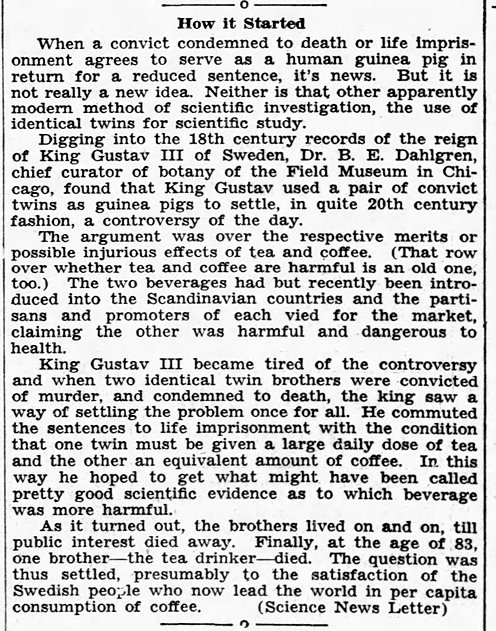
The Sheboygan Press - May 28, 1938
Posted By: Alex - Thu Sep 23, 2021 -
Comments (5)
Category: Experiments, Coffee and other Legal Stimulants, Eighteenth Century
Butt Breathing Tubes
Recent studies suggest that it may be possible to supply oxygen to patients via a "butt breathing tube" rather than by the traditional tube down the throat. This new technique is also known as "enteral ventilation via anus". Caleb Kelly, in the journal Med (Jun 11, 2021) notes:The key to the technique is the use of an oxygen-saturated perfluorocarbon solution that can deliver enough oxygen to make it through the mucus membrane of the intestines and into the blood.
The technique has been demonstrated successfully on mice, rats, and pigs, but not yet on humans.
Josh Bloom, on the American Council of Science and Health site, observes:

image source: The Scientist
Posted By: Alex - Sat Sep 04, 2021 -
Comments (2)
Category: Science, Experiments
The Power of Prayer on Plants
According to the Rev. Franklin Loehr, prayer could supercharge the growth of plants. Pretty much any prayer would work. He detailed his argument in his 1959 book The Power of Prayer on Plants.When Richard Nixon was told of Loehr's results, he reportedly said, "That sounds like a good kind of thinking to me."
However, in 1961, a group of Harvard students tried to replicate Loehr's results and failed to do so. In fact, in their experiment the plants that weren't prayed for at all grew better than plants that were prayed for by either skeptics or believers.

More details from Newsweek (Apr 13, 1959):
Can prayer make plants grow faster and bigger? Skeptics think it laughable, scientists find it irrelevant, and farmers tend to rely on more mundane methods to increase their crops. But the Rev. Franklin Loehr is convinced that the answer is yes, and has just written a book, "The Power of Prayer on Plants," to tell why.
After five years and 900 experiments, the 46-year-old Presbyterian minister reports he and 150 members of his prayer group found that prayed-for wheat and corn seeds grew into bigger seedlings than ones which got no prayer or outright negative prayer. Commenting on their methods last week in his Los Angeles home, Mr. Loehr explained that they used every kin of prayer and found every one effective to a degree.
"There were silent and spoken prayers," he continued, "those to loved ones, and the humble prayer straight to God. But mostly people just talked to the plants, loved them, or scolded them. First I tried buddying up to them, and then I observed that the people getting better results were approaching the plants on their own level of consciousness."
Picking up a copy of the book, he pointed to the jacket, which shows a lone, stunted shoot on the no-prayer side of an experimental seedbed. "He wasn't supposed to be there," explained Mr. Loehr, "so we blighted him with three bursts of negative command."
Mr. Loehr dropped the experiments two years ago, having persuaded himself, at least, of their validity. He is now concentrating on "soul dynamics" prayer for people—not, of course, to make them grow faster and bigger. "The fact is," he concluded, "we used plants to test prayer just as the artificial heart is tested in dogs instead of humans."
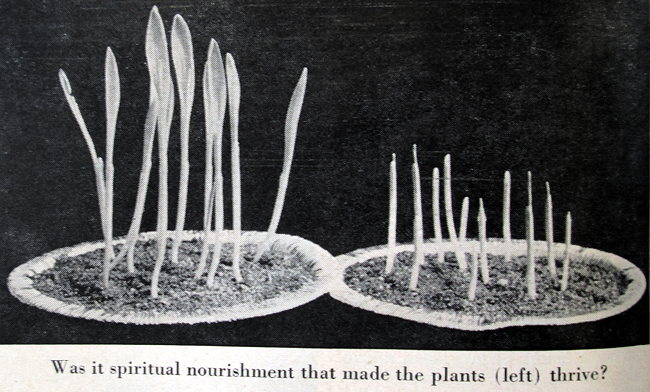
Along similar lines, see our previous post "Does holy water help radishes grow better?"
Posted By: Alex - Fri Aug 06, 2021 -
Comments (2)
Category: Religion, Experiments, Books, 1950s
The Marijuana Sex Experiment
1975: There was a public hoo-ha when details of Dr. Harris Rubin's planned "marijuana sex study" leaked to the press. As described in the St. Louis Post-Dispatch (Dec 7, 1975):The New Scientist noted that, despite the moral outrage, the purpose of the study was actually to generate anti-marijuana propaganda by demonstrating that marijuana inhibits sexual response. At least, that was the anticipated result. But the experiment was never conducted.

Dr. Harris Rubin of the Southern Illinois University School of Medicine at Carbondale
Morton Hunt gives more details in his 1999 book The New Know-Nothings:
On July 18, the Bloomington, Illinois, Daily Pantagraph, which had somehow become aware of the study, ran an article about it, and from then on Rubin's project was in trouble. Newspapers in Illinois, St. Louis, Washington, Chicago, and many other cities ran stories about what quickly became known as the "sex-pot study" or "pot-sex study," a topic so interesting that they ran follow-up stories about it for many months. Displaying suitable outrage, the Christian Citizens Lobby, Illinois governor Daniel Walker, a federal prosecutor, and various Illinois state officials all denounced the study, calling it "disgusing," "pornography," "obscene," and "garbage," and threatening to take action against Rubin.
This was mere growling and snapping, but Congress had the teeth wherewith to bite. Senators William Proxmire and Thomas Eagleton, Democrats but sexual conservatives, attacked it, as did Representative Robert Michel, the ranking Republican member of the House Appropriations subcommittee. Although the secretary of HEW and the president's National Advisory Council on Drug Abuse defended and supported the project, Michel sought to prevent NIDA from funding the Rubin study by tucking an amendment to that effect in the $12.7 billion-dollar 1976 Supplemental Appropriations Bill for HEW, and Senators Proxmire and Warren Magnuson inserted a similar provision into the Senate's version of the bill. The funding of HEW was so crucial to the national well-being that both houses passed the bill with the anti-Rubin provision intact. President Ford signed it into law on May 31, 1976, keeping the vast Social Security system, NIH, and other essential endeavors going—and cutting off Rubin's minuscule funding and putting an end to his research. Rubin had already gathered the alcohol data and he eventually published his results, but the marijuana study died a-borning.
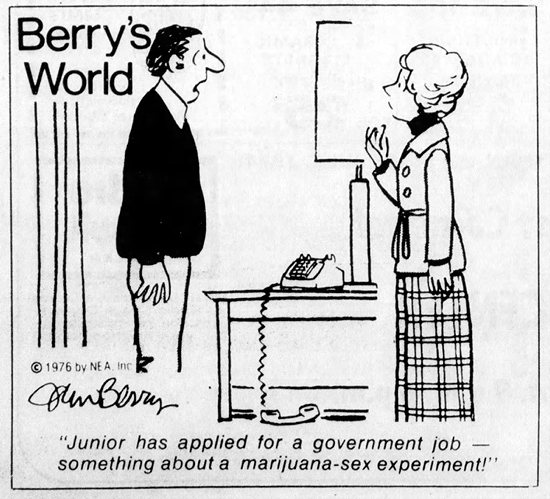
The Sedalia Democrat - Feb 4, 1976
Posted By: Alex - Sat Jul 31, 2021 -
Comments (6)
Category: Drugs, Smoking and Tobacco, Experiments, 1970s, Moral Panics and Public Hysteria
An Experiment on Eye Process
From The Art and Science of Embalming (1896) by Carl Barnes.The illustration shows an experiment by the embalmer W.W. Harris to test the efficacy of injecting embalming fluid through needles inserted at the corners of the eyes. Harris showed that the fluid would come out the veins and arteries in the neck— and if the head were still attached to a body, would then presumably spread throughout the rest of the corpse.
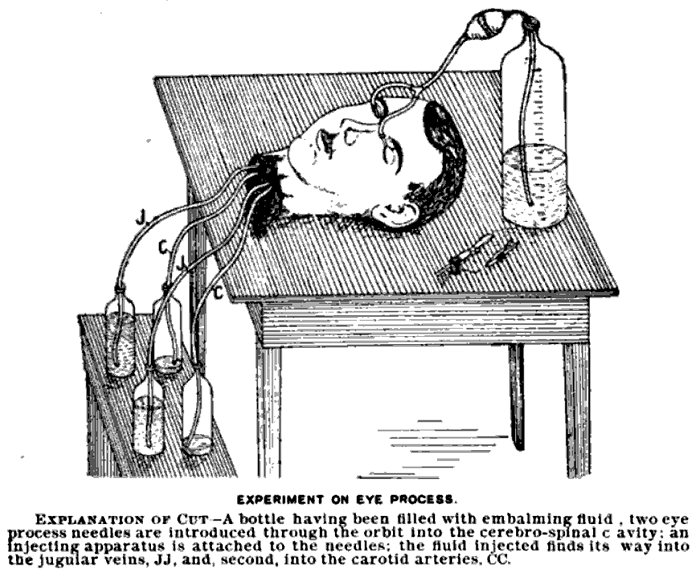
Posted By: Alex - Sun Jun 06, 2021 -
Comments (2)
Category: Death, Experiments, Eyes and Vision
Dr. Munch’s Marijuana Madness
1938: Dr. James Clyde Munch described to his students at Temple University what happened when he smoked "a handful of reefers" as an experiment.I'm thinking there may have been something more than just marijuana in those cigarettes.
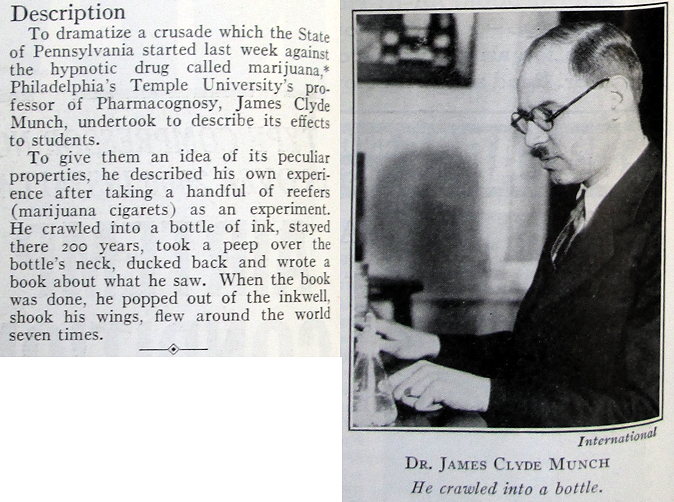
Time - Apr 11, 1938
Munch liked his story about the disorienting effects of marijuana so much that he repeated it at several criminal trials.
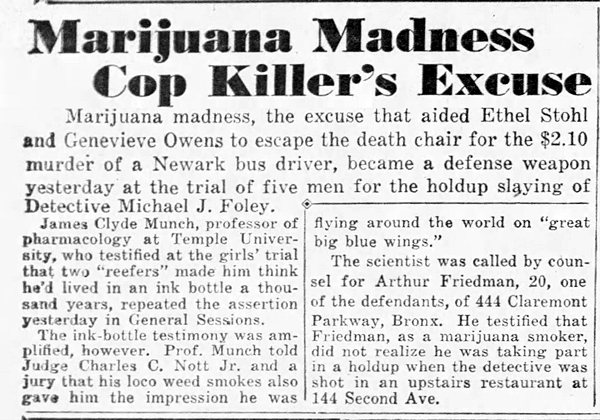
New York Daily News - Apr 8, 1938
Posted By: Alex - Fri May 14, 2021 -
Comments (4)
Category: Drugs, Smoking and Tobacco, Experiments, 1930s
Buried Alive Experiment
1926: French journalist Paul Heuzé sealed himself in an air-tight coffin to investigate how fakirs performed this feat. He lasted one hour and fifteen minutes before signalling that he needed to be let out.More info about Heuzé at Wikipedia.
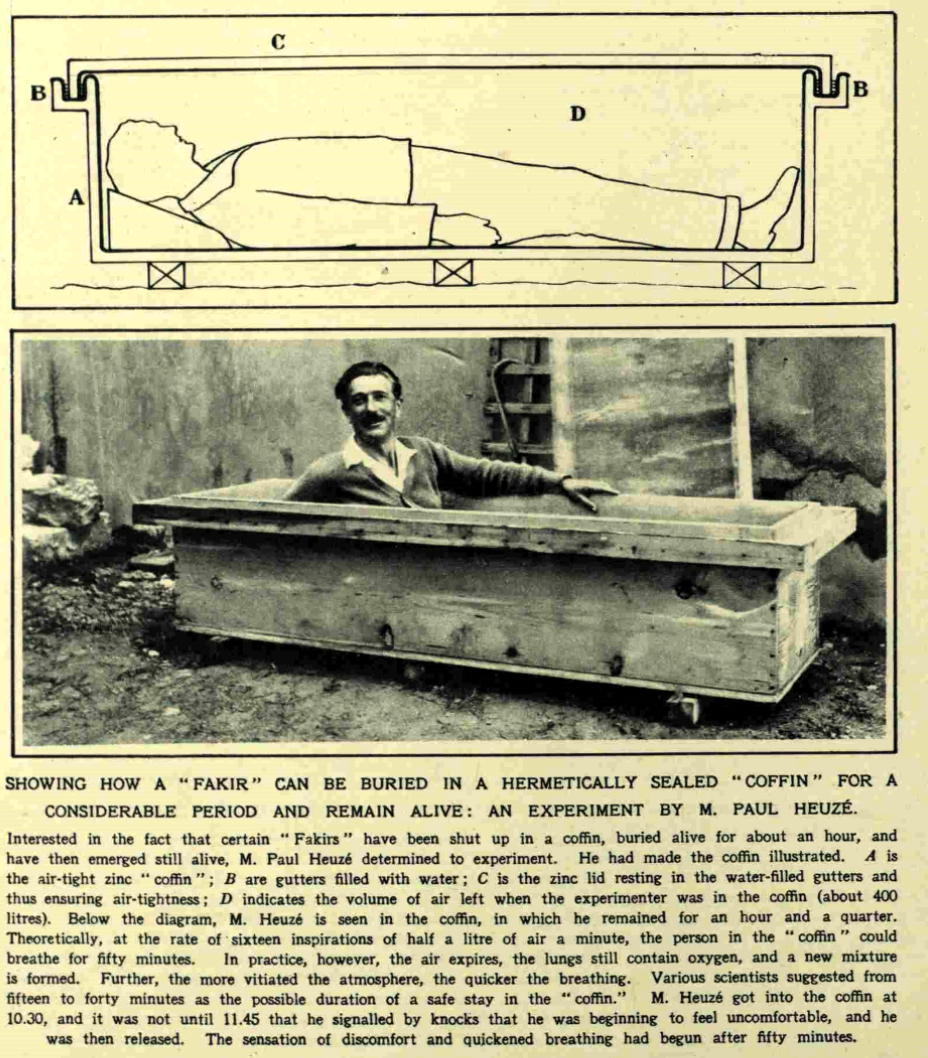
Illustrated London News - Dec 11, 1926
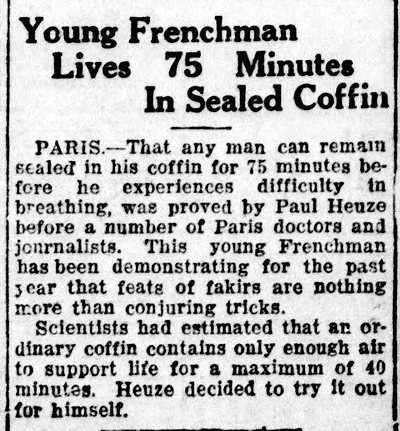
East Liverpool Evening Review - Dec 23, 1926
Posted By: Alex - Mon May 10, 2021 -
Comments (3)
Category: Experiments, 1920s
Pigs Play Video Games
Researchers at Pennsylvania State University recently succeeded in teaching four pigs how to play a video game. Admittedly, the game was pretty simple. The pigs had to use a joystick to move a cursor toward a target wall on the computer screen. If they hit the wall, they'd hear a "bloop" and then get a food reward.The pigs performed at a level far above random chance. However, the researchers noted that their skill level was below that of non-human primates. The scientists speculated that this may have been because it was difficult for the pigs to manipulate the joystick with their snout. Or perhaps it was because all four pigs were far-sighted and "despite attempts to position the computer monitor appropriately, it is impossible to know how well the pigs were able to see, and subsequently correctly discriminate between targets."
More info: Lab Manager, Frontiers in Psychology

Thanks to Gerald Sacks!
Posted By: Alex - Wed Feb 17, 2021 -
Comments (1)
Category: Animals, Experiments, Videogames and Gamers
Upside-Down Rhinos
Recent research has proven that it's safe to hang rhinos upside-down by their feet for up to ten minutes. Future research should let us know whether longer periods, up to half-an-hour, are also safe.More info: Cornell Chronicle, Journal of Wildlife Diseases
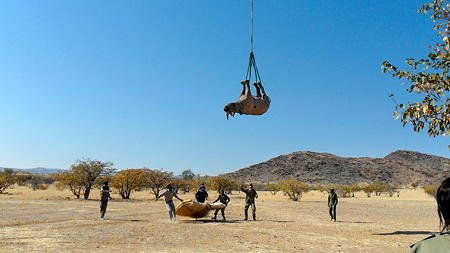
Posted By: Alex - Mon Feb 08, 2021 -
Comments (6)
Category: Animals, Experiments
The Shipwreck Diet
Studies conducted by the U.S. Army in the late 1940s sought to determine the minimum amount of food a person would need to survive if they were shipwrecked on a desert island.One of the oddities the researchers discovered was that if, for some reason, the shipwrecked person had to choose between steak and water, they should choose the water: "Protein has the effect of drying up the body. Therefore eating a steak on a desert island with little or no water available would probably be worse than eating nothing, depending upon how long rescue took."
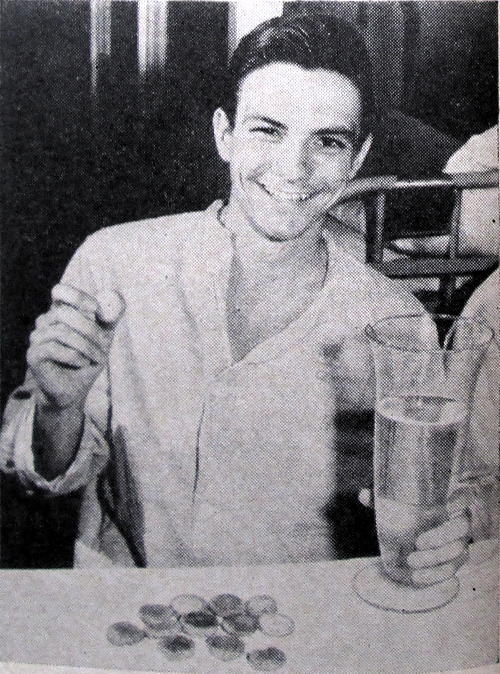
"Shipwreck Diet: One of eleven Army volunteers who for six weeks will live on biscuits and water at the Metropolitan Hospital, New York City, to determine a human survival ration."
Newsweek - Mar 15, 1948
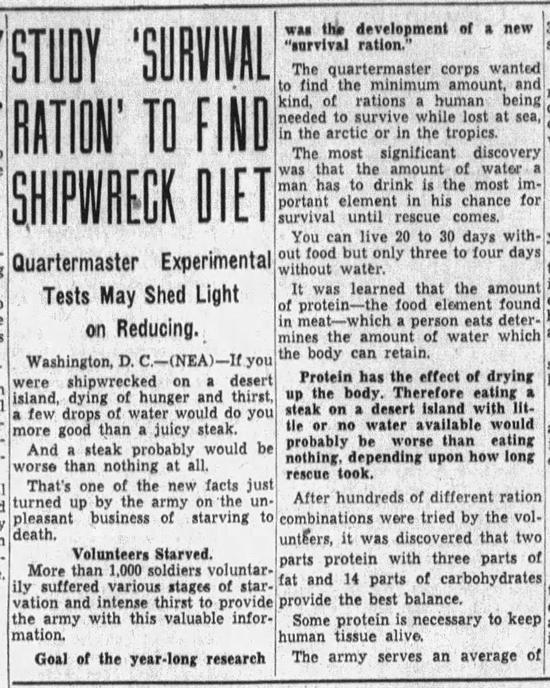

Waterloo Courier - Nov 16, 1949
Posted By: Alex - Mon Nov 16, 2020 -
Comments (4)
Category: Food, Nutrition, Experiments, 1940s, Dieting and Weight Loss

| Who We Are |
|---|
| Alex Boese Alex is the creator and curator of the Museum of Hoaxes. He's also the author of various weird, non-fiction, science-themed books such as Elephants on Acid and Psychedelic Apes. Paul Di Filippo Paul has been paid to put weird ideas into fictional form for over thirty years, in his career as a noted science fiction writer. He has recently begun blogging on many curious topics with three fellow writers at The Inferior 4+1. Contact Us |




